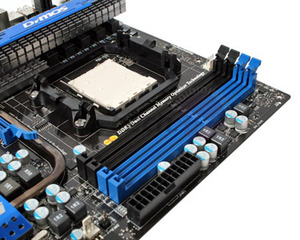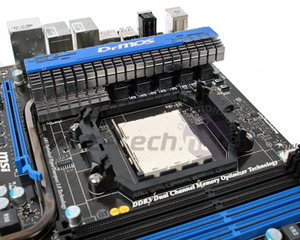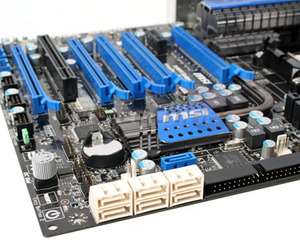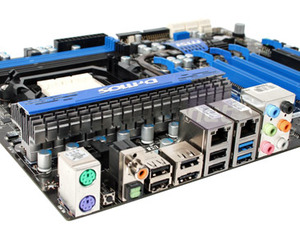First Look: MSI 890FX-GD70 Motherboard
Manufacturer: MSINow for some brand new 890FX love! MSI is keen to roll on with the success of the 790FX-GD70. It's good to see then, that the 890FX-GD70 layout is almost identical to the 790FX-GD70, bar a few minor updates (check this 790FX-GD70 board layout to see for yourself).
These updates include native SATA 6Gbps from the SB850 Southbridge that replaces the older SB750, SATA ports at 90 degrees to the board, and USB 3 support via two rear I/O ports. There are five 16x PCI-E slots in total, and all but the centre slot seem to have the 16 pins to indicate a maximum of 16 lanes of bandwidth - the centre slot has only eight pins. However, we're not exactly sure how the bandwidth is divided between the slots, and this could change from now until the board arrives in the shops anyway.
The five CPU power phases may seem a bit underwhelming, but it's the same that served the 790FX. However, the solid aluminium capacitors have now been replaced with low profile High-c caps instead, but that's a minor update. More notably, the Northbridge and MOSFET heatsinks are still the same single chunk of metal it was before; that means MSI can squeeze in seven expansion slots, instead of just six.
The two-digit LED readout in the middle of the board will still get lost when CrossFire is used - a likelihood in a high-end motherboard - and conversely we still have an IDE port taking up valuable PCB real-estate, while a lone (blue) SATA port gets left on the inside. We can safely say that very few people will not find that ideal, MSI. That extra SATA port is provided by the JMicron 363 I/O chip, which also provides the single eSATA . Eww.
Also on the rear I/O, MSI has gone back to dual-Gigabit Ethernet - something that is becoming less and less common these days - as well as plenty of USB ports, Realtek HD audio (including both types of S/PDIF out) and a clear CMOS button are present too.
The physical buttons have been changed for MSI's new touch-sensitive ones of the X58 XPower, but MSI has yet to develop an 'OC Genie' button for AMD, instead favouring its 'OC Dial' approach. It seems strange, since the Base Clock buttons on its Intel boards effectively do the same thing. Again, the BIOS is just as important as the features and layout on any performance board, so we're hoping MSI has evolved its previously excellent 790FX BIOS for this one, and avoided its problematic but more recent 785G and 890GX BIOSes.
There you go then, two interesting boards from MSI that you can expect to see soon. Let us know your thoughts about either design in the forums.

MSI MPG Velox 100R Chassis Review
October 14 2021 | 15:04















Want to comment? Please log in.